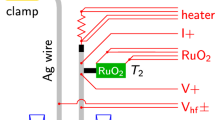Abstract
We have measured the resistivity of pure platinum wires ranging in diameter from 16 mil to 0.3 mil in the temperature range 1.2 to 4.2°K, and observed size-dependent deviations from Matthiessen’s rule. The temperature dependent portion of the resistivity is dominated in this temperature range by a term of the formAT 2, whereA increases from about 12×10−12 Ω cm/°K2 for the thickest wires to 18×10−12 Ω cm/°K2 for the thinnest ones. There is an additional resistivity contribution which appears to increase more rapidly thanT 5, and which also evidences some increase with decreasing wire diameter. The observed deviations from Matthiessen’s rule display temperature and size variations consistent with the theory ofBlatt andSatz, and the magnitude of the deviations can be accounted for by this theory taking into account only that portion of the electrical resistivity produced by electron-phonon scattering. Thus the data are consistent with arguments suggesting that interband electron-electron scattering does not lead to size-dependent deviations from Matthiessen’s rule.
Zusammenfassung
Wir haben im Temperaturbereich von 1,2°K bis 4,2°K den elektrischen Widerstand an dünnen Platindrähten mit Durchmessern von 0,32 mm bis 0,006 mm gemessen und „size-effect”-bedingte Abweichungen von der Matthiessen’schen Regel festgestellt.
Der temperaturabhängige Teil des Widerstandes wird in diesem Temperaturbereich durch einen Term der FormAT 2 beschrieben, wobeiA zwischen den Werten 12·10−12 Ω cm/°K2 für die dicksten Drähte, und 18·10−12 Ω cm/°K2 für die dünnsten Drähte variieren kann. Ein zusätzlicher Widerstandsanteil wächst etwa stärker alsT 5 und zeigt auch einen leichten Anstieg bei abnehmender Drahtdicke. Die beobachteten Abweichungen von der Matthiessenschen Regel zeigen Temperatur- und „size-effect”-Abhängigkeiten, wie sie durch die Theorie vonBlatt undSatz vorausgesagt werden. Die Größenordnung der Effekte wird ebenfalls durch diese Theorie richtig wiedergegeben, wenn man nur den Anteil des Widerstandes berücksichtigt, der durch die Elektron-Phonon-Streuung verursacht wird. Die Ergebnisse zeigen, daß offenbar die Interband-Elektron-Elektron-Streuungen nicht zu den „size-effect”-bedingten Abweichungen von der Matthiessen’schen Regel beitragen.
Résumé
Nous avons mesuré la résistance spécifique dans le domaine de température de 1,2°K à 4,2°K de fils de platine pur avec des diamètres variant de 0,4 mm à 0,01 mm et observé des déviations de la règle de Matthiessen en fonction de l’épaisseur des fils. La fonction décrivant la résistance spécifique possède une partie dépendante de la température qui est dominée, dans notre domaine de température, par un terme de la formeAT 2, oùA passe d’une valeur de 12×10−12 Ω cm/°K2 pour les fils les plus épais à une valeur de 18×10−12 Ω cm/°K2 pour les fils les plus minces.
De plus nous avons observé une contribution additionelle qui semble augmenter plus rapidement queT 5 et qui en plus montre une certaine augmentation lors d’une diminution du diamètre des fils. Les déviations de la règle de Matthiessen que nous avons observées montrent des variations en fonction de la température et de l’épaisser des fils, qui sont en accord avec la théorie deBlatt etSatz et la grandeur de ces déviations peut être expliquée en ne considérant que la partie de la résistance provenant de la diffusion électron-phonon. Ainsi les résultats expérimentaux confirment l’hypothèse que la diffusion électron-électron entre les bandes de conduction ne produit pas de déviations de la règle de Matthiessen, fonctions de l’épaisseur des fils.
Similar content being viewed by others
References
Andrew, E. R.: Proc. Phys. Soc. (London)A 62, 77 (1949).
Olsen, J. L.: Helv. Phys. Acta31, 713 (1958).
Luthi, B., andP. Wyder: Helv. Phys. Acta33, 669 (1960).
Blatt, F. J., andH. G. Satz: Helv. Phys. Acta33, 1007 (1960).
Ya Azbel’, M., andR. N. Gurzhi: J.E.T.P. (U.S.S.R.)42, 1632 (1962; English Translation in Sov. Phys. JETP15, 1133 (1962).
Van Zytveld, J. B., andJ. Bass: Phys. Rev.177, 1072 (1969).
Husstad, B., andJ. Lothe: Physica Norvegica2, 258 (1967).
Aleksandrov, B. N.: J.E.T.P. (U.S.S.R.)43, 399 (1962); English Translation in Sov. Phys. JETP16, 286 (1963).
Holwech, I., andJ. Jeppesen: Phil. Mag.15, 217 (1967).
Tanner, D. B., andD. C. Larsen: Phys. Rev.166, 652 (1968).
Chopra, K. L.: Phys. Lett.15, 21 (1965).
Blatt, F. J., A. Burmester, andB. La Roy: Phys. Rev.155, 611 (1967).
Yaqub, M., andJ. F. Cochran: Phys. Rev.137, A 1182 (1965).
Garland, J. C., andR. Bowers: Phys. Rev. Lett.21, 1007 (1968).
Wyder, P.: Phys. kondens. Materie3, 263 (1965).
Ziman, J. M.: Electrons and Phonons (Oxford Univ. Press, 1960).
White, G. K., andS. B. Woods: Phil. Trans. Roy. Soc. (London)A 251, 273 (1959).
Van Dijk, H.: Physica30, 1498 (1964).
Schriempf, J. T.: Phys. Rev. Letters19, 1131 (1967);20, 1034 (1968).
White, G. K., andR. J. Tainsh: Phys. Rev. Letters19, 165 (1967).
Herring, C.: Phys. Rev. Letters19, 167 (1967).
Colquitt, L.: J. Appl. Phys.36, 2454 (1965).
Anderson, A. C., R. E. Peterson, andJ. E. Robichaux: Phys. Rev. Letters20, 459 (1968).
Rice, M. J.: Phys. Letters20, 1439 (1968).
Dingle, R. B.: Proc. Roy. Soc. (London)A 201, 545 (1960).
Huebener, R. P.: Phys. Rev.A 140, 1834 (1965).
Ketterson, J. B., L. R. Windmiller, S. Hornfeldt, andF. M. Mueller: Solid State Comm.6, 851 (1968).
Ketterson, J. B., andL. R. Windmiller: Phys. Rev. Letters20, 321 (1968).
Author information
Authors and Affiliations
Additional information
Supported in part by the U.S. Atomic Energy Commission under Contract No. AT(11-1)-1247.
This work was presented at the Conference on Electron Mean Free Paths in Metals, September 3–5, 1968, in Zürich.
N.S.F. Summer Research Student during a portion of this work.
Rights and permissions
About this article
Cite this article
Freeman, R.H., Blatt, F.J. & Bass, J. The resistivity of fine platinum wires. Phys kondens Materie 9, 271–282 (1969). https://doi.org/10.1007/BF02422571
Received:
Issue Date:
DOI: https://doi.org/10.1007/BF02422571




